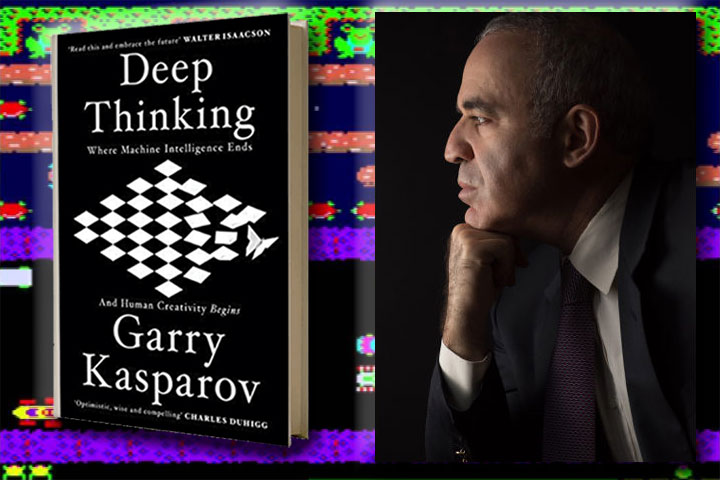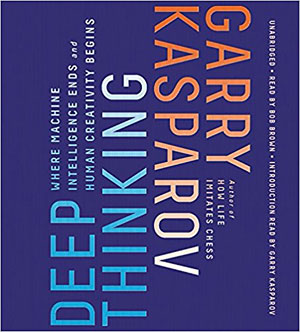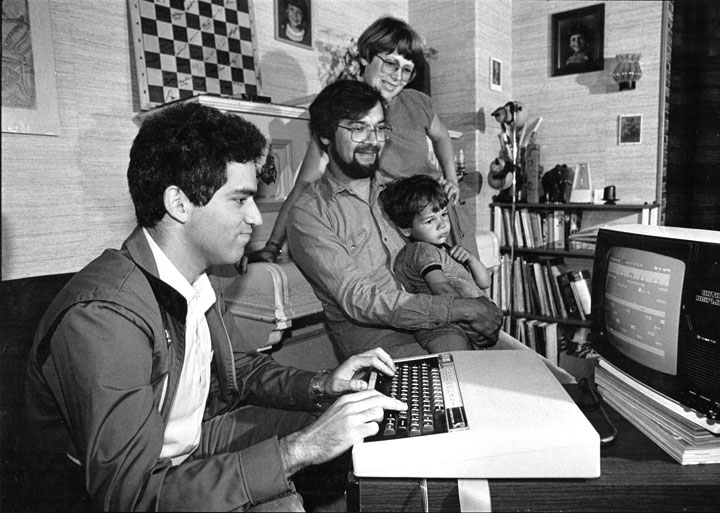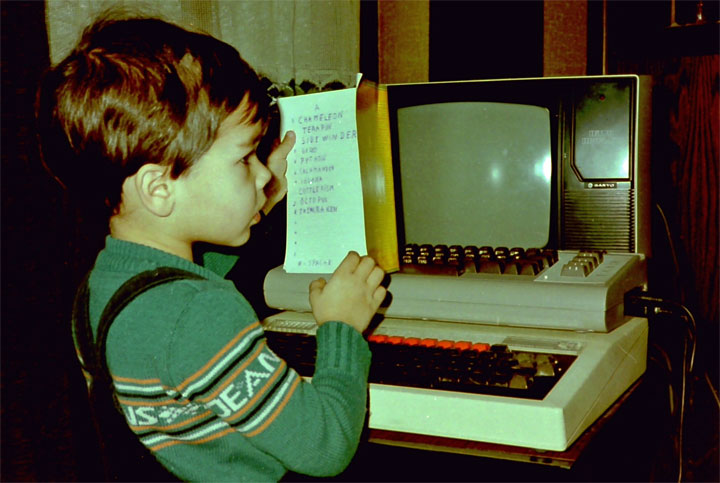


 Garry Kasparov has written many books, mostly about chess, or at least with heavy chess connotations. In May this year it was a book on machine intelligence and human creativity. I consider Deep Thinking (link at the bottom of this page) his most important work to date. It touches on a development that will change the course of human existence. Ever more experts and thinkers are beginning to realizes that after the cognitive, agricultural and industrial revolutions our species is faced with a new and even more momentous change, brought about by the advent of Artificial Intelligence.
Garry Kasparov has written many books, mostly about chess, or at least with heavy chess connotations. In May this year it was a book on machine intelligence and human creativity. I consider Deep Thinking (link at the bottom of this page) his most important work to date. It touches on a development that will change the course of human existence. Ever more experts and thinkers are beginning to realizes that after the cognitive, agricultural and industrial revolutions our species is faced with a new and even more momentous change, brought about by the advent of Artificial Intelligence.
So the experts are talking and writing about it. But is a former World Champion really qualified to publish a book on the subject? He certainly is, for some very obvious reasons. Chess was the first and most dramatic intellectual area in which human and machine intelligence clashed. It is the paradigm for what we are facing in countless other fields. AI scientists do well to study the development of chess intelligence in artificial systems, and to use this example to extrapolate to other realms of human activity that are experiencing a similar challenge.
As a legendary World Champion Garry Kasparov was at the forefront of the AI chess experiment. Like nobody else he experienced the encroachment of machines in an intellectual pursuit that until very recently had been uniquely human. And in this book he describes quite vividly what this encounter, at the highest level, felt like. And it befits us to take notice.
I will be reviewing Kasparov's book in the future. I was at his side for most of the journey he describes, and experienced most of the exciting and sometimes traumatic events at close quarters. I also need to debate his conclusions regarding Artificial Intelligence, which are somewhat more optimistic than mine. But I must keep that for a later date. Today I want to bring you a Christmas tale that was described on eight pages at the beginning of the book. It has been told before, e.g. in his 1987 autobiography Child of Change, which we excerpted for the 25th anniversary of our company. But in Deep Thinking, three decades later, he has added to the narrative his thoughts on the effect the first professional database had on tournament chess. When reading this and other passages in the book (which I strongly advocate you purchase) it is well to bear in mind that before computers Garry had had a very privileged access to chess information, and that in spite of this he did everything in his power to democratise its use.
Well, on to the Christmas tale on how it all started. The pictures, I should mention, are not part of the book but have been inserted by an interested party.
By Garry Kasparov [excerpted from Deep Thinking, with kind permission]
I WAS INTRODUCED to computers in 1983, although I didn't play chess with them at the time. The British computer company Acorn, the "British Apple," sponsored my match against Viktor Korchnoi in London that year, and of course their products were on display. Businesses, hobbyists, and other early adopters across Europe were paying large sums for the first few generations of home computers and Acorn was doing very well. I won the match, putting me a step away from my first world championship contest with Anatoly Karpov the next year, and was also given an Acorn home computer to take back to Baku. I flew on Aeroflot sitting next to the Soviet ambassador, and my fragile new trophy had its own VIP seat and blanket.
To me, coming from the USSR, owning a computer seemed a little like science fiction. First, I had dedicated my life to climbing up the chess Olympus and this left very little time for other interests. Second, the USSR was still a computing desert outside of research institutions. A Soviet clone of the 1977 Apple II, the AGAT, came out around 1983 and slowly started to appear in schools across the country, but it was far out of reach for most private citizens, costing around twenty times the average monthly Soviet salary. And like most Soviet knock-off tech, it wasn't even a very good clone of a computer that was already six years old. America's BYTE magazine wrote in 1984 that "the AGAT wouldn't stand a chance in today's international market, even if they gave it away."
This was far from just a little Cold War jab. The PC revolution was already well under way in America by this time. They were still expensive for what you got, but easily available to the middle class. The hugely popular Commodore 64 was released in August 1982. The standard-setting IBM PC XT came out in early 1983. By late 1984, over 8 percent of American households owned a computer. For comparison, the number of personal computers in Baku, Azerbaijan, a capital city of over a million people, probably went from zero to one when the plane landed with me and my Acorn.
I would like to say this first encounter with a computer was a transformative moment, but as I said, I was a little busy at the time. My cousins and friends mostly used my eight-bit Acorn, a BBC Micro model, I believe, to play video games. One in particular would come to alter my perception of computers and my life in an important way, but it wasn't a chess game. It involved moving a little green frog across traffic.

One day early in 1985, I received, a package from a stranger named Frederic Friedel, a chess fan and science writer based in Hamburg, Germany. He sent me a nice note and a floppy disk containing several computer games, including my new favorite, called Hopper [watch a session on YouTube]. I admit I spent much of my free time over the next few weeks playing Hopper and setting ever-higher record scores.
A few months later, I traveled to Hamburg for several events, including the computer simul, and I also visited Mr. Friedel at his suburban home. I met his wife and two young sons, Martin, age ten, and Tommy, age three. They made me feel quite at home and Frederic was eager to show me the latest developments on his own computer. I managed to work into the conversation that I had completely mastered one of the little games he had sent me.
"You know, I'm the best Hopper player in Baku," I said, omitting any mention of the total lack of competition. I told him that I had scored sixteen thousand points and was a little surprised that this extraordinary number failed to elicit at least a raised eyebrow.
"Very impressive," Frederic said, "but that's not such a big score in this house." "What? You can beat it?" I asked. "No, not me." "Ah, okay, Martin must be the video game whiz." "No, not Martin."
It was with a sinking feeling that I realized the smile on Frederic's face meant that the household Hopper champion was the three-year-old. I was incredulous. "You can't mean Tommy!" My fears were confirmed when Frederic led his little boy over to the computer and sat him down next to us as the game loaded. Since I was the guest they let me go first and I rose to the occasion with a personal best of nineteen thousand points.

My success was short-lived, however, as Tommy [above on Frederic's lap] took his turn. His little fingers were a blur and it wasn't long before the score read twenty thousand, then thirty thousand. I conceded defeat to avoid having to sit watching through dinnertime.
Losing to a little kid at Hopper was easier on my ego than any loss to Karpov, but it still gave me food for thought. How was my country going to compete with a generation of little computer geniuses being raised in the West? Here I was, one of the few people in a major Soviet city with a computer, and I had been handily outperformed by a German toddler.

"He can read and type??" Garry asked in horror. Of course, that was essential for entering passwords in advanced adventure games...
And so, when I signed a sponsorship deal with the computer company Atari in 1986, I took as payment over fifty of their newest machines to bring back to form a youth computer club in Moscow, the first of its kind in the Soviet Union. I continued to supply the club with hardware and software acquired on my travels and it became a hub for many talented scientists and hobbyists.
They would often give me lists of equipment they wanted for their projects, leading to some amusing scenes at the airport when I would return from my travels like Father Christmas delivering presents. Mixed in with the chess fans welcoming me home, there would be computer experts hoping I'd managed to find the items on their wish lists. I even recall being met by a shout that would get quite a lot of attention from security at any airport today: "Garry! Did you bring the Winchester?!" It was a much-coveted type of hard drive.

Garry (behind Tommy) playing computer games with Frederic and sons at their home in Hollenstedt, Germany, on Christmas Eve 1985. On the left is Nigel Short who, eight years later, would challenge Kasparov for the World Championship title.
Frederic and I also had the chance to talk about the potential implications computers had for professional chess. Businesses were rapidly adopting PCs for spreadsheets, word processing, and databases, so why couldn't this sort of Hoppering be done for chess games? This would be a powerful weapon, one that I couldn't afford to be the last to have.
As described above, our conversations led to the creation of the first version of ChessBase, a name that soon became synonymous with professional chess software. In January 1987, I tried out an early version of the program to prepare for a special simultaneous exhibition against a strong team. I had narrowly lost a similar event in 1985, playing against eight members of a professional German league team at the same time. I had come in tired and overconfident, especially since I didn't know much about most of my opponents and had no way to quickly prepare for them.

For the rematch, I discovered how much ChessBase was going to change professional chess and my life. Using an Atari ST and a ChessBase diskette labeled "00001" that I was given by Frederic and Matthias, I was able to bring up and review my opponents' previous games in hours, a process that would have taken weeks without a computer. With just two days of preparation I felt comfortable going into the match and won in crushing fashion, 7-1. That was when I knew I was going to be spending a lot of time in front of a computer for the rest of my career. I just didn't realize yet how much of that time would be spent playing against them.
HOW QUICKLY and completely computers came to dominate chess preparation was illustrated a few years later when an interviewer and photographer came to where I was staying. The photographer wanted some pictures of me at a chessboard to accompany the story. The only problem? I didn't have a chessboard with me! All my preparation was done on my laptop, a Compaq that really stretched the definition of "portable." It must have weighed close to twelve pounds. Even so, it was far lighter and more efficient than traveling with my paper notebooks and a stack of opening encyclopedias. The advantages would accumulate when the Internet made it possible to download the latest games nearly as soon as they had been played, instead of having to wait weeks or months for them to be published in a magazine.
Soon nearly every Grandmaster traveled to every tournament with a laptop, although there was a jagged generational break in this regard. Many older players found them too complicated, too alien, especially after having decades of success with their traditional training and preparation methods. Laptops were also still very expensive, and few players had my advantages of sponsorship deals and world championship prize purses.
How professional chess changed when computers and databases arrived is a useful metaphor for how new technology is adopted across industries and societies in general... I was in my twenties when the digital information wave rolled over the chess world, and it was a fairly gradual one, not a tsunami. Flicking through games on a screen was far more efficient than on printed materials, a real competitive advantage but not a nuclear bomb. The impact of the Internet a few years later was just as great, dramatically accelerating the information warfare that Grandmasters wage against each other over the board. A brilliant new opening idea played in a game in Moscow on Tuesday could be imitated by a dozen players around the world on Wednesday. It shortened the lifespan of these secret weapons, what we call opening novelties, from weeks or months to hours. No more could you hope to ensnare more than a single opponent with a clever trap.
Of course, that was only true if your opponents were also online and up to date, which wasn't the case for a while. Asking a fifty-year-old Grandmaster to ditch his beloved leather-bound notebooks of analysis, printed tournament bulletins, and other preparation habits was like asking a successful writer to switch to a word processor or an artist to start drawing on a screen instead of a canvas. But in chess, it was a matter of adapting to survive. Those who quickly mastered the new methods thrived; the few who didn't mostly dropped down the rating lists.
There's no way to prove causation, but I'm certain that the rapid decline of many veteran players in the 1989-95 span, when ChessBase became standard, had much to do with their inability to adjust to the new technology. The 1990 rating list included over twenty active players born before 1950 among the top one hundred in the world. By 1995, there were just seven, and only one among the elite: the ageless Viktor Korchnoi, born in 1931, who was my opponent in that 1983 London candidates match sponsored by Acorn. Another exception was my great rival Karpov, born in 1951, who stayed near the top into his fifties despite his personal reluctance to embrace computers and the Internet. But along with his tremendous talent and experience, as a former world champion with considerable resources he also counted on the assistance of colleagues for his research, an advantage few others had. Reducing the advantage of being able to afford assistants, or "seconds," as they are called in chess, in a tribute to the age of duels, was one of the many democratizing impacts technology had on the chess world.
While they may have shortened the careers of a few older players, computers also enabled younger players to rise more quickly. Not just the playing engines, but because of how PC database programs allowed elastic young brains to be plugged into the fire hose of information that was suddenly available. Even I am startled to watch kids zipping from one game to the next, one branch of analysis to another, in the blink of an eye. Computer-centric training also has drawbacks, and I'll get to those later, but there is no doubt it tipped the playing field, or the chessboard, even further toward youth. As my professional career progressed, not only would I be facing the challenge of every champion to fend off the next generation of players, but it would be a generation that had grown up with sophisticated tools that hadn't existed when I was a kid. I was born just in time to ride this wave instead of being swept away by it. But this timing also put me on the front lines against a new enemy that was growing stronger by the day. The chess machines were finally coming for the world champion, and, as of November 9, 1985, that was me.
 Deep Thinking: Where Machine Intelligence Ends and Human Creativity Begins 1st Edition
Deep Thinking: Where Machine Intelligence Ends and Human Creativity Begins 1st EditionBy Garry Kasparov (Author), Mig Greengard (Contributor)
Garry Kasparov's 1997 chess match against the IBM supercomputer Deep Blue was a watershed moment in the history of technology. It was the dawn of a new era in artificial intelligence: a machine capable of beating the reigning human champion at this most cerebral game.
That moment was more than a century in the making, and in this breakthrough book, Kasparov reveals his astonishing side of the story for the first time. He describes how it felt to strategize against an implacable, untiring opponent with the whole world watching, and recounts the history of machine intelligence through the microcosm of chess, considered by generations of scientific pioneers to be a key to unlocking the secrets of human and machine cognition.
Kasparov uses his unrivalled experience to look into the future of intelligent machines and sees it bright with possibility. As many critics decry artificial intelligence as a menace, particularly to human jobs, Kasparov shows how humanity can rise to new heights with the help of our most extraordinary creations, rather than fear them. Deep Thinking is a tightly argued case for technological progress, from the man who stood at its precipice with his own career at stake.
Available from Amazon.com and other outlets. ISBN-13: 978-1610397865 ISBN-10: 161039786X. Hardcover $19.04; paperback $16.99; Kindle $11.60.
 He has made the most popular and best-selling DVDs in our inventory.
He has made the most popular and best-selling DVDs in our inventory.
With his dynamic style, Kasparov had an epoch-making influence on the development of tournament chess at the end of the 20th century. The basis of his exceptional position in chess was extraordinary talent combined with hard work, enormous will-power and a boundless memory. He himself once characterised his style as "a combination of Alekhine, Tal and Fischer".
Kasparov won most of the competitions in which he took part. With his series of victories in 1999 he built up a lead of 80 points in the Elo list; the rating of 2851 which, until the advent of Magnus Carlsen, had never been equalled, despite Elo inflation. Kasparov also set the standard as an author of chess books, with the greatest attention being earned by his series on the world chess champions "My Great Predecessors".
Order these very popular Kasparov DVDs in the ChessBase Shop